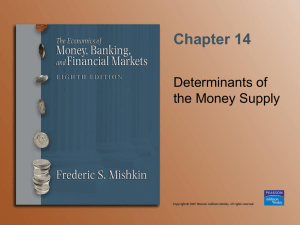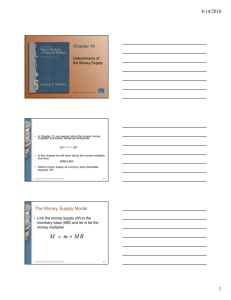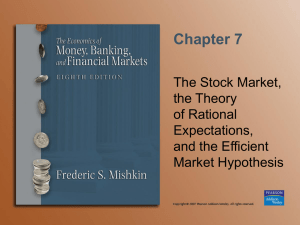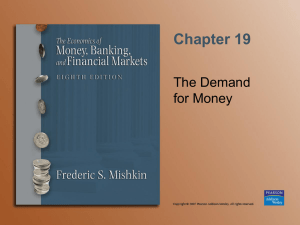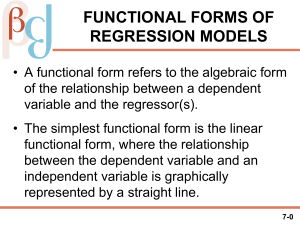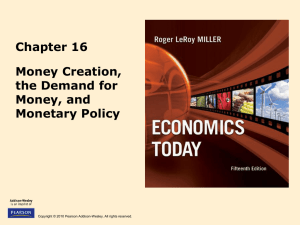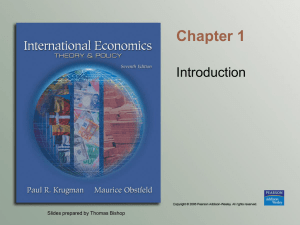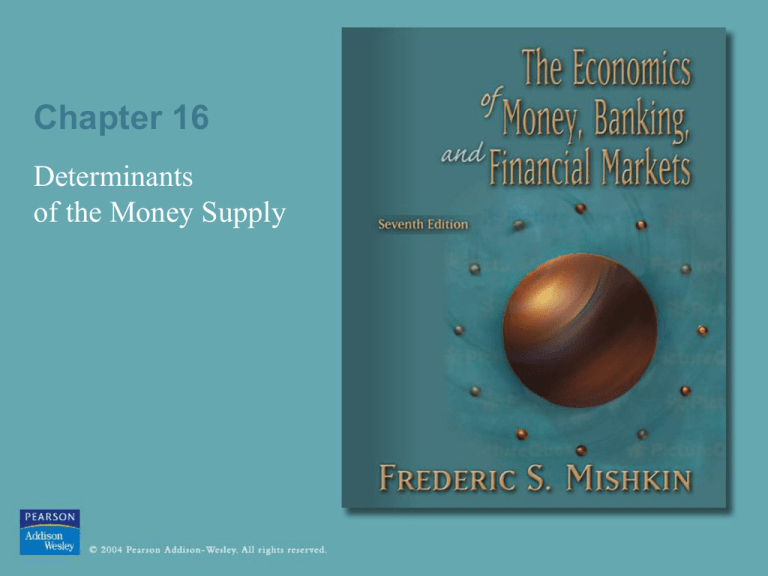
Chapter 16
Determinants
of the Money Supply
Deriving a model of the money supply
process
• Because central bank can exert more precise
control over the MB than total reserves alone
(Chap. 15), we model the links between the money
supply and MB.
• We shall derive a money multiplier (a ratio that
relates the change in the money supply to a given
change in in the MB)
• We focus on M1.
© 2004 Pearson Addison-Wesley. All rights reserved
16-2
Deriving the Money Multiplier
M = m MB
m is the money multiplier, which tells us how much the
money supply changes for a given change in the MB.
R = RR (required reserves) + ER (excess reserves)
RR = r × D
C = desired level of currency
D = checkable deposits
c = C/D = currency ratio
e = ER/D = excess reserves ratio
© 2004 Pearson Addison-Wesley. All rights reserved
16-3
Money Multiplier
M = m MB
Deriving Money Multiplier
R = RR + ER
RR = r D
R = (r D) + ER
Adding C to both sides
R + C = MB = (r D) + ER + C
1. Tells us amount of MB needed support D, ER and C
2. $1 of MB in ER, not support D or C
MB = (r D) + (e D) + (c D)
= (r + e + c) D
© 2004 Pearson Addison-Wesley. All rights reserved
16-4
D=
1
r+e+c
MB
M = D + (c D ) = (1 + c) D
M=
1+c
r+e+c
m =
1+c
r+e+c
MB
m < 1/r because no multiple expansion for currency and because as
D ER
Full Model
M = m (MBn + DL)
© 2004 Pearson Addison-Wesley. All rights reserved
16-5
Factors that Determine the Money
Multiplier
1. Changes in the required reserve ratio r
2. Changes in the currency ratio c
3. Changes in the excess reserves ratio e
a. market interest rates: the banking system’s
excess reserves ratio e is negatively related to the
market interest rate i.
b. expected deposit outflows: the excess
reserves ratio e is positively related to expected
deposit outflows.
© 2004 Pearson Addison-Wesley. All rights reserved
16-6
Excess Reserves Ratio
Determinants of e
1. i , relative Re on ER (opportunity cost ), e
2. Expected deposit outflows, ER insurance worth more, e
16-7
Additional Factors that Determine the
Money Supply
MB = MBn + DL
MB: monetary Base
MBn : nonborrowed monetary Base
DL: discount loans from the central bank
M = m × (MBn + DL)
1.
Changes in the MBn: the money supply is positively related
to the MBn.
2.
Changes in the DL: the money supply is positively related to
the level of DL from the central bank.
© 2004 Pearson Addison-Wesley. All rights reserved
16-8
Factors Determining Money Supply
© 2004 Pearson Addison-Wesley. All rights reserved
16-9
Money Supply
© 2004 Pearson Addison-Wesley. All rights reserved
16-10
Determinants
of the Money
Supply
© 2004 Pearson Addison-Wesley. All rights reserved
16-11
Deposits at Failed Banks: 1929–33
© 2004 Pearson Addison-Wesley. All rights reserved
16-12
e, c: 1929–33
© 2004 Pearson Addison-Wesley. All rights reserved
16-13
Money Supply and Monetary Base: 1929–33
© 2004 Pearson Addison-Wesley. All rights reserved
16-14




